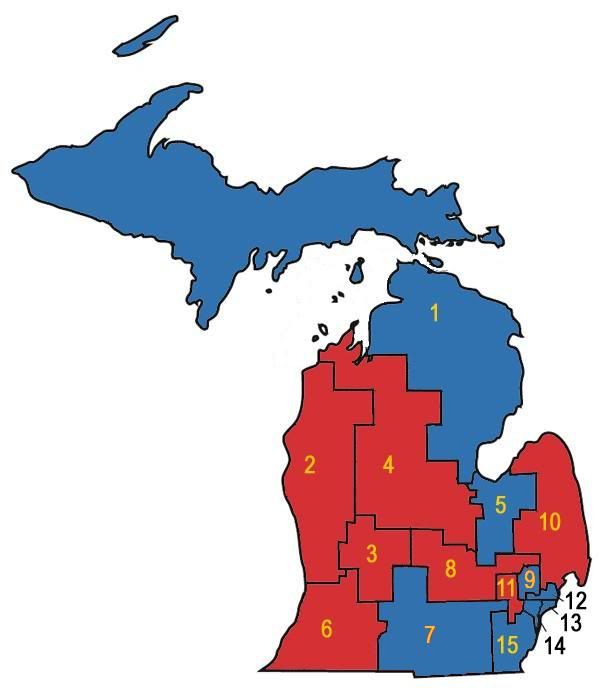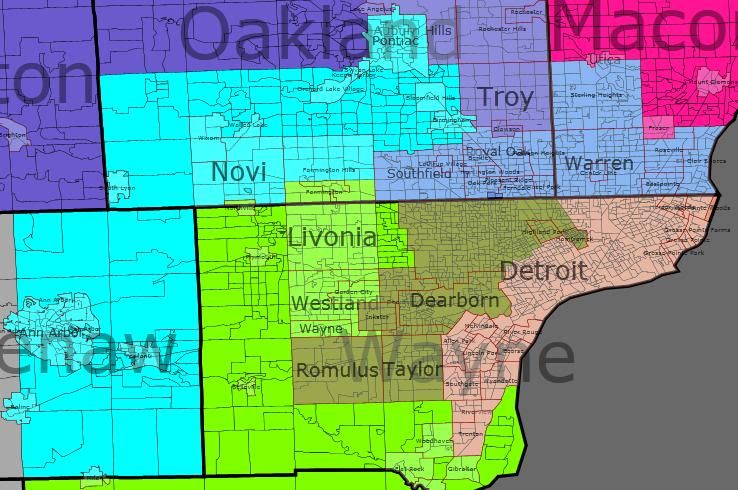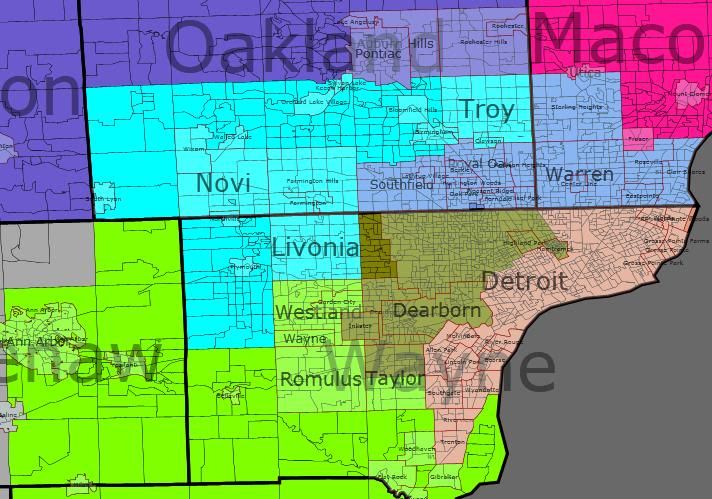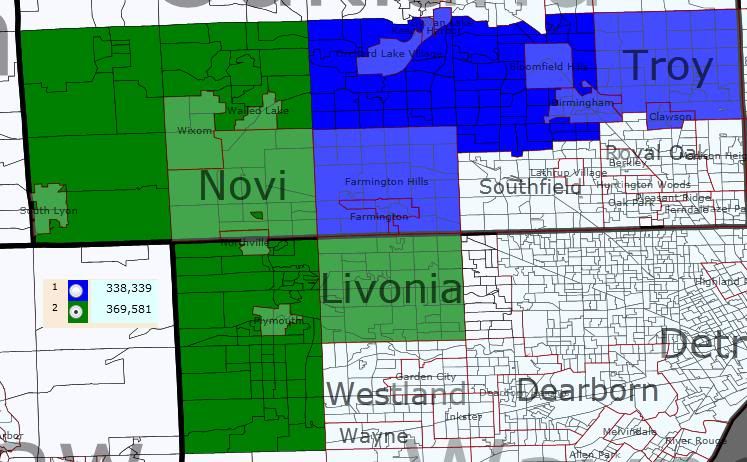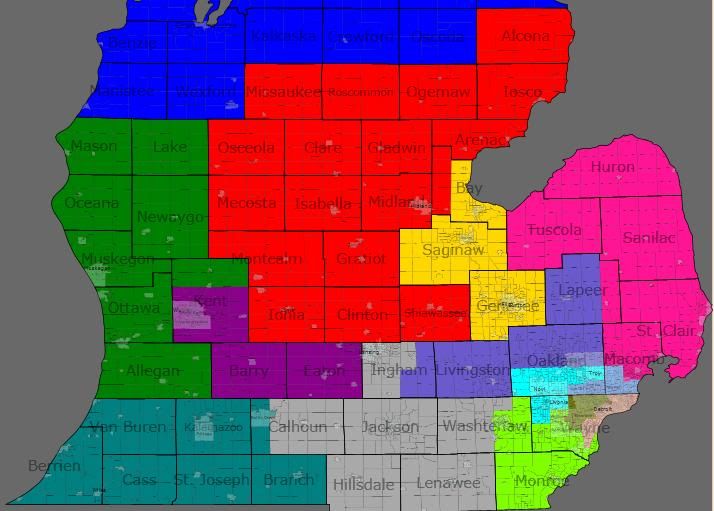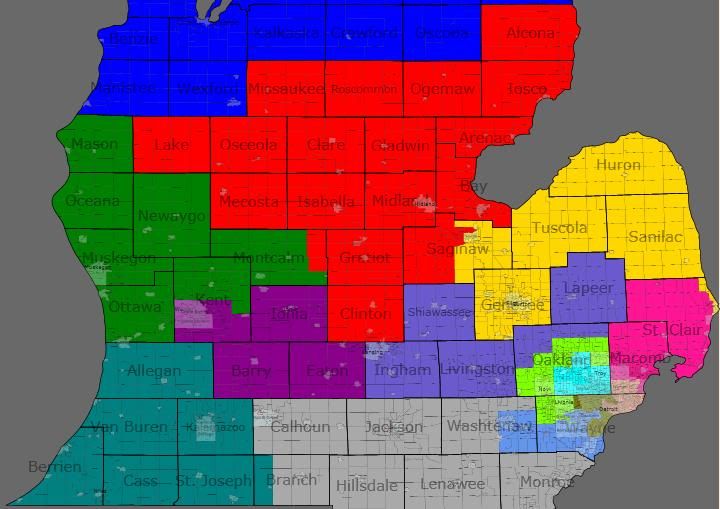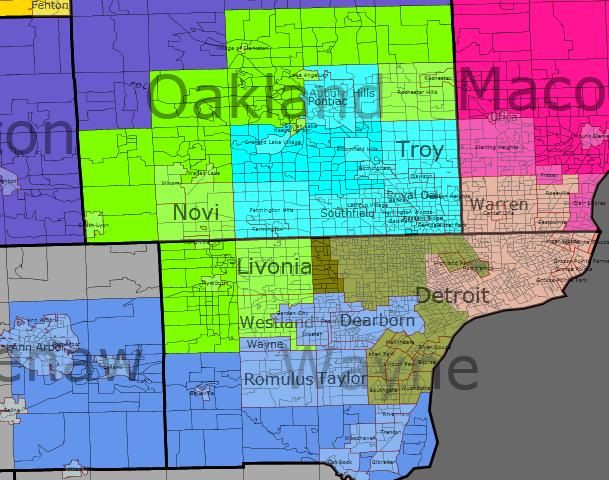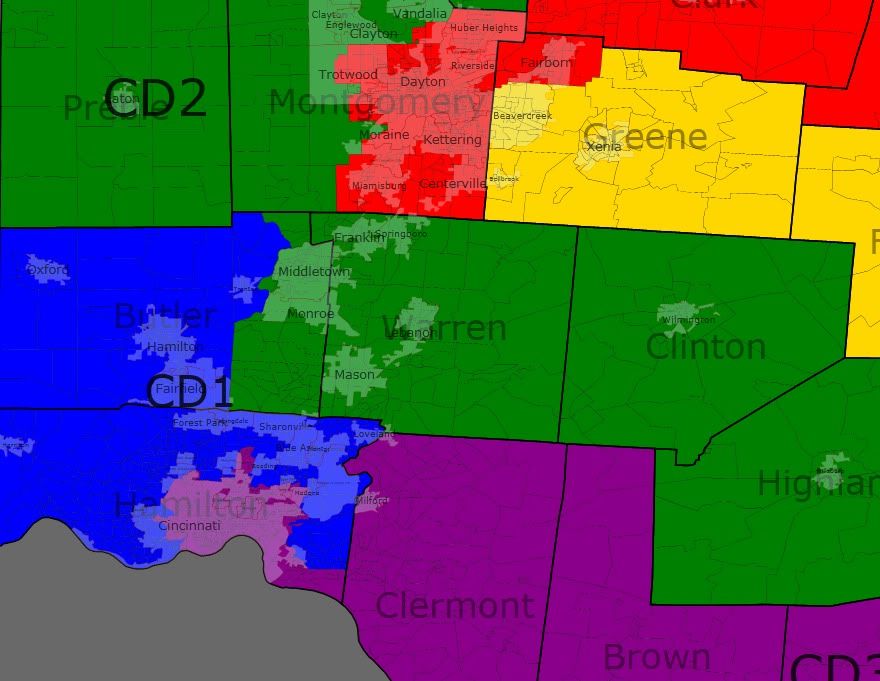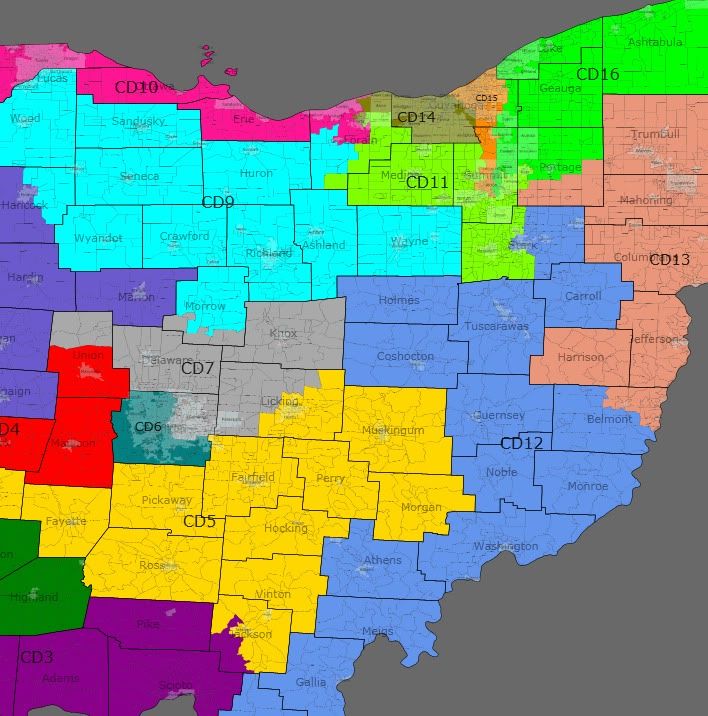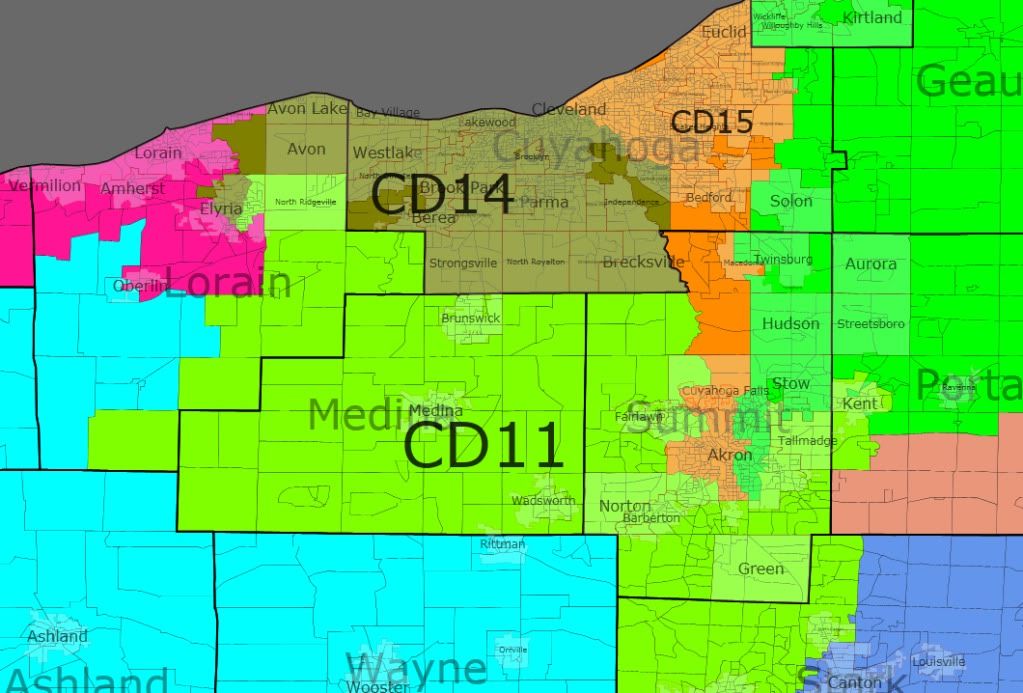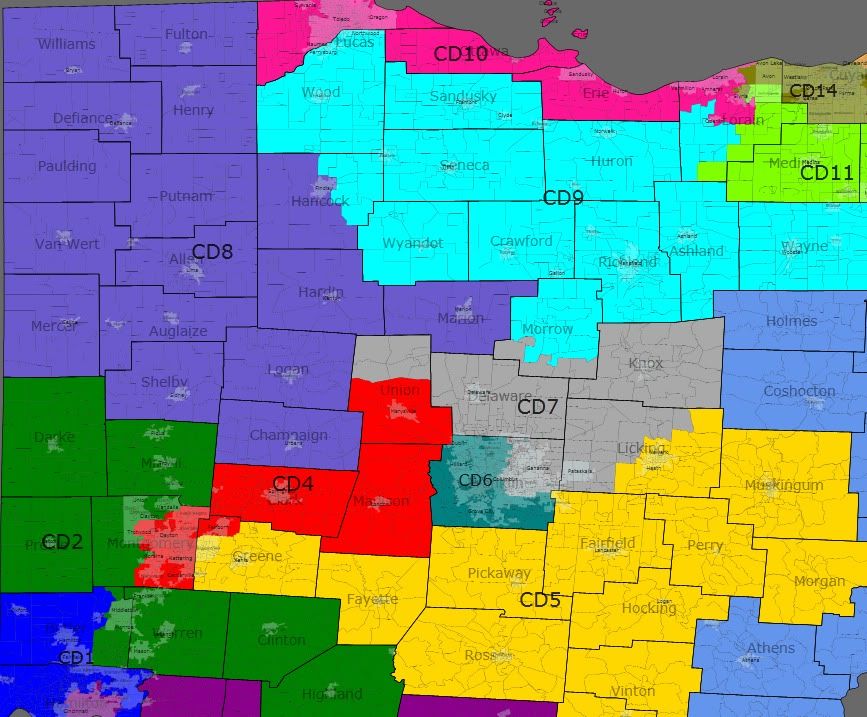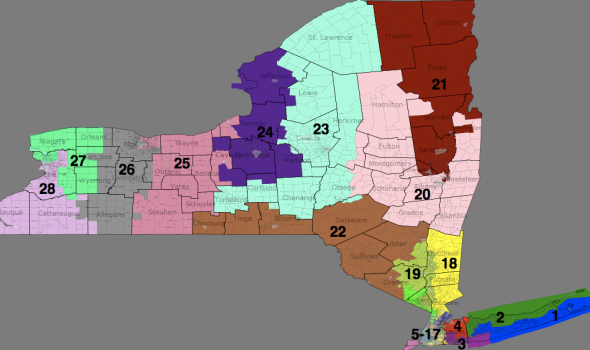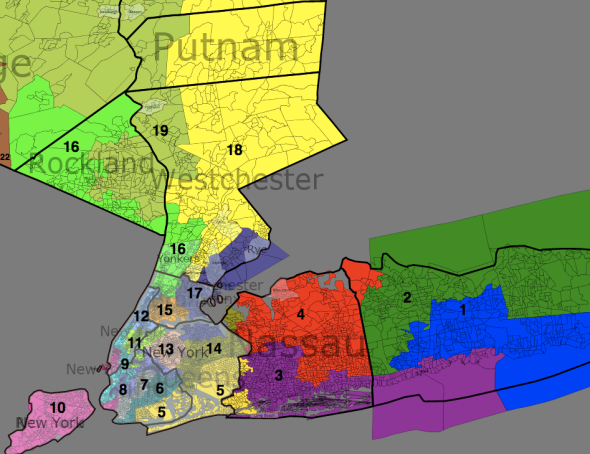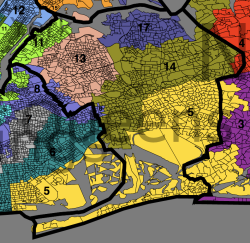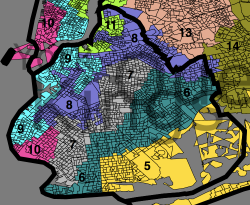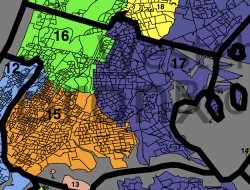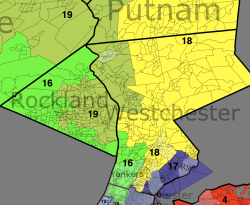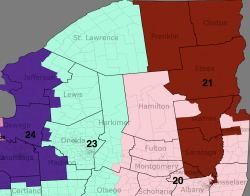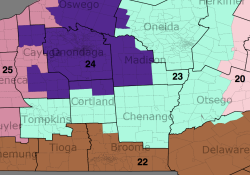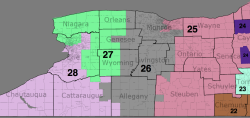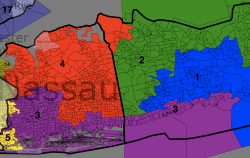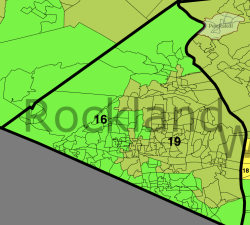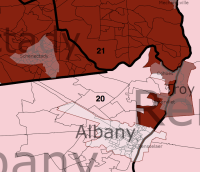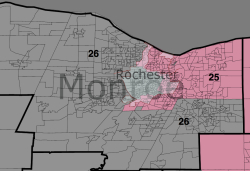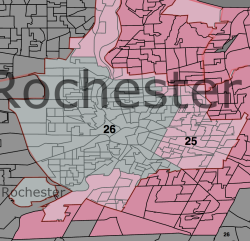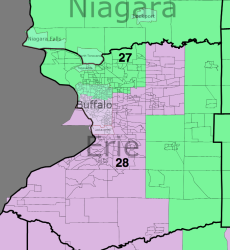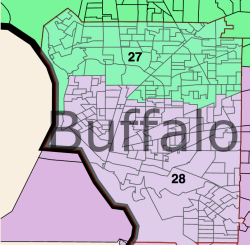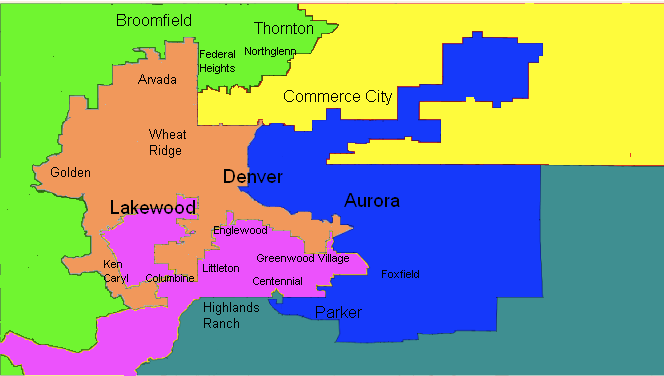Texas redistricting is the big prize on offer in 2010 state elections. Both sides have strong motives to want control, quite aside from the fact that it’s got 32 seats already and will probably have 36 next time round. Democrats, still smarting from Tom DeLay’s mid-decade shenanigans, would love to control the maps, allowing them to take advantage of rapid Hispanic growth and perhaps to draw a district for a longtime conservative state legislator who can scrabble out enough of a foothold to keep himself afloat with rural whites for another few years.
Republicans want to maintain their huge edge and to fix elements of the Delaymander that are falling apart – districts like TX-32 and TX-10 where a changing population will draw the ground out from under the Republicans by 2020. They also don’t want to see a return to the 1991 Democratic gerrymander.
My impression is that Republicans have the edge, so I’ve drawn a gerrymander for them. However, with Democrats controlling the Justice Department, minority rights will have to be respected. Texas Republicans cannot just draw four new districts for white Anglos, or the map will be thrown out.
Dave’s Redistricting App estimates Texas’ population as being 54% white, 11% black, 4% Asian and 31% Hispanic.
That ought to shake out to four black-majority districts, but the population just isn’t packed enough for that to be possible. I’ve kept the three districts that are already designed to elect black representatives, although they’re all black-plurality rather than black-majority. Two are at 47% black and are fairly safe, whilst the other is 38% black and may be Hispanic-plurality by 2020. That said, it’ll still probably elect a black representative from there for years afterward.
You can’t draw an Asian district, although in Houston an Asian-influence district might just be possibility come 2020. That leaves us with Texas’ 7.8m Hispanics. That ought to equate to 11 Hispanic-majority districts. I tried to do that and preserve a GOP gerrymander, but the numbers aren’t quite there. Instead I got 10 and an Austin district, where Doggett could easily be succeeded by a Hispanic.
In the meantime, I think I preserved a GOP gerrymander fairly well. There are 24 districts McCain won and in 20 of those he got 60% of the vote or more. In only one Republican did McCain get less than 58% of the vote.
[Map]
West Texas
TX-01 – blue
[Demographics]
Obama: 65 McCain: 34
Likely candidate: Silvestre Reyes
First things first: yes, I’ve renumbered the districts. This is partly because I started in west Texas, headed east to the sea then spiralled clockwise round the state, finishing in the Houston suburbs and was too lazy to swap the colours later. But it’s also partly because there’s almost no rime nor reason to Texas’ current numbering system, so I don’t see the urgent need to change.
Reyes’ district shrinks slightly as El Paso grows. The district gets negligibly less Democratic, but I don’t think he’s going to be quaking in his boots.
TX-02 – dark green
[Demographics]
Obama: 62 McCain: 37
Likely candidates: Henry Cuellar, Ciro Rodriguez (?)
This district covers the Mexican border from El Paso to Zapata county and clocks in at a hefty 81% Hispanic. It looks an awful lot like Ciro Rodriguez’s current district, only straying into some south-eastern (and not entirely Hispanic) outskirts of San Antonio.
On the flipside, it now contains Laredo. Cuellar won the last primary, and as the Democratic primary will be the decider, I wouldn’t bet against Republicans crossing over to support him. I’m not even certain whether Ciro lives in this district, but either way he might consider running in the new third instead, except for one thing…
TX-03 – dark purple
[Demographics]
Obama: 38 McCain: 61
Likely candidates: Mike Conaway (?), Ciro Rodriguez (?), Henry Bonilla (?)
Democrats have always been keen on the idea of a Hispanic-majority West Texas seat. This seat gives it to them, just, but in a form they can’t win. The core of the old 11th around Midland is here, but rather than taking in San Angelo and the Hill Country, the district instead dives south-east to take in central San Antonio.
Although Hispanics make up 50% of the district’s population, many of them can’t vote (and plenty of the more rural ones are quite conservative) so McCain beat Obama by 50,000 votes here.
The flip-side of this is that the district is guaranteed to swing left, as rural west Texas depopulates and Hispanics become eligible to vote. Right now around 40% of the district’s inhabitants (and 60% of its Hispanics) live within Bexar county.
Given that trend, Conaway might decide to give the new 3rd a miss and move to the 10th, which northern bits of Midland protrude into. Who could step into the breach for the GOP? A Hispanic candidate would help, although primary voters might not warm to him. How about Henry Bonilla?
TX-09 – light blue
[Demographics]
Obama: 39 McCain: 60
Likely candidates: ?
This is essentially a Hill Country and Colorado River watershed district. A few almost uninhabited counties aside, the district is anchored in the west by San Angelo and bits of Austin and its suburbs in the east.
The rest of the district is largely rural, with Brady probably the largest town outside Travis and Tom Green counties. I’m not sure who the GOP would pick to run here, but I’d put good money he’d try to grab a seat on the agriculture committee.
TX-10 – magenta
[Demographics]
Obama: 34 McCain: 65
Likely candidates: Mike Conaway (?), Chet Edwards (?)
Now that Charles Stenholm is busy with lobbying, there’s much less need for Republicans to draw three blood-red districts in west and north-west Texas. Instead I’ve created a series of strips heading east-west and reaching into Central Texas in an attempt to combine ultra-Republican West Texas with very Republican Central Texas.
This district is a two county tall line through West Texas, taking in north Midland, Big Spring, Sweetwater and Abilene amongst others before abruptly turning south-east. From there it extends just far enough to take in Killeen and half of Waco.
If Mike Conaway decides he’s too crazy to feel safe representing a majority-Hispanic district, he might run here. Otherwise there are plenty of local legislators willing to step up. The district contains 170,000 (mostly Democratic) voters from Bell County, 130,000 from McLennan County and 110,000 from Abilene. So whether the primary winner would be from Killeen, Waco, Abilene or even somewhere further west is an open question.
Either way, I can’t see Chet Edwards running here. Depending on which side of Waco he lives on he might be resident here and he’d like to represent Fort Hood again, but the only bit shared between this district and the current TX-17 is western McLennan county. He won’t want a district that borders New Mexico.
South Texas
TX-04 – red
[Demographics]
Obama: 69 McCain: 31
Likely candidates: Ruben Hinojosa
McAllen is big enough for its own district now. I made up the numbers with south-eastern Hidalgo county, including Hinojosa’s hometown of Mercedes.
At 88% Hispanic, almost certainly the US’ most Hispanic district.
TX-05 – yellow
[Demographics]
Obama: 63 McCain: 36
Likely candidates: ?
An amalgam of the current 28th, 27th and 15th districts, this district takes in Brownsville, Herlingen, Kingsville and a lot of thinly populated rural areas. No current representative lives here, although Solomon Ortiz might move if he doesn’t like the 6th. Either way, he’ll surely face a primary from a local boy.
TX-06 – teal
[Demographics]
Obama: 44 McCain: 55
Likely candidate: Solomon Ortiz
This district begins near Corpus Christi and continues along the coast as far as Jackson and Calhoun counties. To this it adds a fairly Hispanic hinterland of counties a little further inland. So far, so understandable.
However, it then sends a dogleg north-east to pick up enough of southern Bexar county (including south-central San Antonio) to make it Hispanic-majority.
I tried to clean up the dogleg both to improve Republican prospects and to make it look less like an obvious gerrymander, but it can’t really be hidden.
At 54% Hispanic it’s less vulnerable on voting rights grounds than the 3rd, but if Solomon Ortiz runs here expect him to involve the courts.
Either way, of course, Republicans will be finding it difficult by 2020, especially if they’re still chasing the nativist vote. Still, this could be a pick-up in 2012 with a decent candidate.
[San Antonio map]
TX-07 – grey
[Demographics]
Obama: 58 McCain: 41
Likely candidate: Charlie Gonzalez
This district isn’t radically changed from the old TX-20. It continues to be a metro San Antonio district with a Hispanic majority, although not as much of one now that so many other districts have taken bites out of the city.
Still, at 54% Hispanic I don’t see Gonzalez having too many problems winning re-election.
TX-08 – light purple
[Demographics]
Obama: 44 McCain: 55
Likely candidate: Lamar Smith
The northern bits of the old TX-21 are removed for this district so that it’s made up of majority white sections of northern San Antonio as well as western Guadalupe county and the counties north of Bexar.
Smith might be in trouble if Hispanics if northern San Antonio rapidly gets more liberal or more Hispanic, but as the district is at 63% McCain right now he ought to be able hold them off for a few years yet.
North Texas
TX-11 – light green
[Demographics]
Obama: 29 McCain: 70
Likely candidate: Randy Neugebauer, Chet Edwards (?)
Now that Charlie Stenholm is no more, you could make Neugebauer’s turf into a more reasonably shaped district. Or you could just use it to annoy Chet Edwards. Guess what I did?
This district begins in the Llano Estocado around Lubbock and heads east along county lines until it hits the Metroplex exurbs. It extends as far as Mineral Wells but afterwards turns south and south-east, shadowing my TX-10. It gets as far as McLennan County, taking in eastern Waco, before the district reaches its population complement.
This district is more like Chet Edwards’ than TX-10. It includes around 180,000 of his current constituents and all or part of four counties he represents (Hood, Somervell, Bosquet and McLennan). On the other hand, 75% of the district is new, it voted for McCain by forty points, it borders New Mexico and he may not even live here. If he runs here, he’s a brave man.
TX-12 – metallic blue
[Demographics]
Obama: 24 McCain: 75
Likely candidate: Mac Thornberry
I really tried to minimise the pain amongst Texas Republicans by spreading it evenly. That’s very difficult to do with TX-12.
Any district beginning in the Panhandle has a long way to go before it hits an area of demographic strength. What’s more, it has to go through the northern exurbs of the Metroplex, which are solidly Republican and heavily populated.
If I’d gerrymandered a little harder, I could have got this district to Fort Worth. But even then, it’d still be a 70% McCain district, so why bother?
Instead I just chucked all the Panhandle into the district then marched the district along the counties bordering Oklahoma, before turning south to pick up northern bits of Denton County.
TX-13 – terracotta
[Demographics]
Obama: 38 McCain: 61
Likely candidate: Kay Granger (?)
Whilst Kay Granger could run here, she’d work just as well in TX-23 (although it is slightly more marginal) and has no pressing need to move. It’s more likely that this will be filled by new blood. Whether it’s a hard-right suburbanite or a a hard-right exurbanite is the major question here.
Arguably this isn’t a North Texas district but a DFW district. Whilst the bulk of its geographical area is made up two counties west (Park and Wise) and two south (Hill and Johnson) of the metroplex, it sends an arm into Tarrant County, picking up south-eastern Fort Worth and central Arlington. Nearly half of the district lives in this arm.
Yet whilst the 325,000 people within Tarrant County in the district are only 45% white and voted for Obama 58-41, the rest of the district is 85% white and went for McCain 75-24. So long as the margin in the rural/exurban sections remains so lopsided, this’ll stay safely Republican and it’ll behave like a North Texas district.
If the Tarrant County section starts to dominate or if the outlying areas start to moderate, things will get closer. But even if it’s looking a bit ropy come 2020, it’ll likely take a wave year to flip it.
Incidentally, Chet Edwards currently represents the two southern counties of this district. However, I can’t see him running here because a) he doesn’t live here and b) I’m not convinced he’d win the primary. He currently represents less than 30% of the district’s residents and those two counties have less than 20% of TX-13’s Democrats. I just can’t see black and Latino voters in Fort Worth and Arlington (who’ll likely be decisive in the Democratic parimary) deciding that the representative they really need is a conservative white guy from central Texas.
DFW Metroplex
[map]
TX-14 – greenish brown
[Demographics]
Obama: 38 McCain: 61
Likely candidate: Michael Burgess
Population growth shrinks this county heavily. The old TX-26 gives up its portion of Tarrant County, splitting it beween TX-13, TX-21 and TX-23, and its spur into Cooke county joins north Denton in TX-12.
On the other hand, it takes over south-east Denton from the old TX-24 and extends across the border into Collin County, picking up Frisco and the eastern fringes of McKinney.
Burgess’ margins improve 6 points net from 58-41.
TX-15 – orange
[Demographics]
Obama: 37 McCain: 61
Likely candidate: Sam Johnson
TX-15 could be entirely confined to Collin County, but I’ve decided not to so as to give myself a little more freedom.
Which is not to say that it’s not a Collin County district – the Dallas County part of the district contains less than 4% of its inhabitants. More specifically, it’s a Plano-McKinney district, and around 9 points more Republican net.
TX-17 – dark blue
[Demographics]
Obama: 61 McCain: 38
Likely candidate: Pete Sessions (?)
No, this isn’t really Pete Sessions’ intended district, but it might be the one where he actually lives, as I can’t work out which bit of Dallas he lives in. If Pete can win a district that’s only 30% white, then I’m a gazebo. If he lives here, he’ll move, probably to TX-20. That said, TX-20 is probably more likely to include his home anyway.
(Yes, I did draw these districts before checking where each incumbent lives. Nevertheless, in general I got away with it – DFW is a slight exception and even there it’s clearable.)
As it is, this is the Metroplex’s new Hispanic district. I have no idea who the likely new incumbent would be here.
TX-18 – slightly pale yellow
[Demographics]
Obama: 79 McCain: 20
Likely candidate: Eddie Bernice Johnson
The basic shape of the district isn’t changed enormously and it remains a plurality-black district. In fact, it’s now blacker than it used to be, up from 42%. That said, I couldn’t find any way of getting to 50%.
TX-19 – grassy green
[Demographics]
Obama: 39 McCain: 60
Likely candidates: Joe Barton, Chet Edwards (?)
This district begins in south-western Tarrant and south-eastern Dallas county, but only to absorb swing whites in the area within a much redder district. From there’s it’s a long strip south-south-east through Barton’s base in Ennis county, Navarro, Limestone, Freestone, Roberton and north Brazos (including Bryan and College Station).
This isn’t wildly dissimilar to Barton’s current district, which differs mostly in that it turns east at Freestone and in that it includes more of the Metroplex.
If Chet Edwards doesn’t require, here’s probably his best bet to challenge, as the southern half of the district is pretty familiar to him. That said, Barton is pretty well-embedded in the district and we can’t assume Edwards will win any district just because it’s slightly less Republican than his current one.
TX-20 – salmon pink
[Demographics]
Obama: 41 McCain: 58
Likely candidates: Pete Sessions, Ralph Hall
There was no active need to screw Ralph Hall over in this map, but I don’t think that’s inherently unlikely in a Republican gerrymander. There are several reasons for this.
Firstly, he’s 86 and plenty of ambitious state legislators in North-East Texas would like to see him retire so they can replace him. Secondly, his committee assignments aren’t crucial to Texas – his seniority on Energy and Commerce is considerable, but Joe Barton is already ranking member and is 26 years younger, whilst Science and Technology is a relatively minor committee with a lot of Texas Republicans on it, including Lamar Smith as the third in seniority. Thirdly, Hall used to be a Democrat and whilst he’s effectively been a Republican since he joined Congress, he’s still not the member they most want to protect.
None of this means he will be drawn out of his district. Rockwall County could join the new TX-16, although it’d require a lot of shifting around amongst the DFW districts. Nevertheless, it’s questionable whether Hall will be running for re-election in 2012, so I’ve drawn Rockwall into the new TX-20.
The rest of the district is made up of northern and north-eastern Dallas County, including Richardson, Rowlett, Addison, University Park, Highland Park, bits of Garland and much of north Dallas. A lot of this is already represented by Pete Sessions and whilst a district extending into Rockwall instead of Irving might be new, it shouldn’t pose a challenge. And Ralph Hall certainly shouldn’t, as this much more Sessions’ district than it is Hall’s.
TX-21 – reddish brown
[Demographics]
Obama: 39 McCain: 60
Likely candidate: Kenny Marchant
This district no longer includes the Denton county portions of Carrolton, but otherwise Marchant has no reason to complain. Although he does pick up a fair amount of black voters near the Fort Worth-Arlington boundary, his new district went by McCain by over twenty points.
What’s more, the new district is a lot less likely to slip away from under his feet than the last one. Now that the southern part of the old TX-24 is gone, Marchant represents the third least Hispanic district of all Texas’ predominantly urban districts (beaten only by TX-14 and TX-15 just to his north). It’s therefore unlikely that increasing Hispanic eligibility to vote will cut his margins as much as will happen elsewhere.
TX-23 – very light blue
[Demographics]
Obama: 42 McCain: 58
Likely candidate: Kay Granger
The last district wholly within the Metroplex is also the one Republicans will be most wary of. It includes the bits of Tarrant Granger already represents plus a little more on central Fort Worth. Of course, that kind of reduction in size tends to betoken population growth. And this being Texas, population growth means Hispanics.
At 24% Hispanic, TX-23 could become quite hairy by 2020. Unfortunately there’s no obvious way to avoid this – Fort Worth doesn’t have a huge amount of monolithically Hispanic neighbourhoods, and some of them have been dropped into TX-13, but it has enough of them scattered in every area for it to be hard to minimise Hispanics.
Therefore, Granger may have to play up her moderate bona fides. Maybe she’ll hold it, maybe she won’t. A lot will depend on how much she can cut Democratic margins amongst the Hispanic community.
East Texas
TX-16 – bright green
[Demographics]
Obama: 29 McCain: 70
Likely candidate: ?
This is basically Ralph Hall’s district minus Ralph Hall. A few lines are straightened up, it grabs a couple of small counties and now only splits Collin County, but nothing to write home about.
However, without Rockwall in the district it’ll lack an incumbent, so expect a free-for-all in the Republican primary. Just don’t expect any Democrat to stand a chance in the general.
This is a district so red I really should have worked out a way to send it into Tarrant to help out Granger.
TX-22 – muddy brown
[Demographics]
Obama: 35 McCain: 64
Likely candidate: Jeb Hensarling
This is in some ways a Dallas district, as it provides more than a third of the district’s population and is the biggest contributor to the total by some margin. Certainly the district’s centre of gravity lies in the suburban and exurban parts of the old TX-5.
On the other hand, to the core of that district I’ve added a bunch of thinly populated East Texas counties reaching down towards Dallas. Whilst it’s not going to be enough to worry Dallas resident Hensarling about a possible primary, it does keep the district nice and red and provides it with a potential out into a future existence as a proper East Texas district when overwhelmed Republican districts start to have to flee DFW in 2020.
TX-24 – very dark purple
[Demographics]
Obama: 31 McCain: 69
Likely candidate: Louie Gohmert
What can I say here? Like TX-16, the changes are not major. Three counties to the north are lost and in return most of Cherokee county is taken. Had I not been playing to strict population equality rules – no more than 1000 plus or minus than the average – I’d have taken the entire county and created a district that actually looks naturally shaped.
Either way, it’d still be a monstrosity for Democrats and a sinecure for Gohmert.
TX-25 – dark pink
[Demographics]
Obama: 34 McCain: 65
Likely candidate: Ted Poe (?)
This was originally designed as a fairly pure South-east Texas district. Although population equality necessitated a move out of that area, I had hoped to do it just by hopping Galveston Bay and grabbing most of Texas City.
Then I checked and found out Ted Poe lives in Humble. After deciding it wasn’t practicable to essentially swap Brady and Poe into each other’s districts, I then had to abandon the Galveston Bay hop and head into Harris County, necessitating a fair bit of boundary reworking between this district, TX-26 and TX-31. That and the need to keep TX-31 as black as possible account for most of the very ugly lines in north Harris, with population equality causing the rest.
Nevertheless, South-east Texas still predominates here, as less than 25% of voters are resident in Harris county. Indeed, Ted Poe still might not live here, as I only included about two-thirds of Humble. Poe isn’t completely immune from a challenge emanating from Beaufort or Port Arthur.
Either way though, Republicans are heavily favoured.
TX-26 – dark grey
[Demographics]
Obama: 26 McCain: 73
Likely candidate: Kevin Brady
My initial plan called for this seat to be based around Montgomery County, heading down into Harris to pick up some northern outliers of Houston.
Having to draw Ted Poe back into TX-25 screwed that up, especially as a lot of the north Houston suburbs ended up being needed for Sheila Jackson-Lee’s district.
Instead the district limits itself to only a few forays over the Harris-Montgomery line and instead heads eastward to take in San Jacinto, Polk and Tyler counties. These appear to be fairly standard East Texas counties and are thus quite different from rapidly growing Montgomery county, but the culture clash shouldn’t be a problem for Brady, as he already represents everything in this district bar the portions of Harris.
At 73% McCain, this is a very safe district.
Central Texas
TX-27 – emerald green
[Demographics]
Obama: 40 McCain: 59
Likely candidate: John Carter
I’m skipping over Houston for now and heading straight on to central Texas. Except of course that I’ve mostly done central Texas using the tendrils of TX-10, TX-11, TX-19 and TX-22.
In practice, therefore, I’m left with only three districts. Once you exclude the metro Austin one, you’re left with two and this is the only one that makes a concerted effort to stay within the area’s borders.
I can’t say I’m entirely happy with it. I’d hoped to make Carter safer than this, but screwing over Chet Edwards sucked up many of the reddest bits of central Texas and the southern parts of this district aren’t quite as Republican as Erath, Hamilton and Correll counties, which have been removed.
That said, this district isn’t a disaster. Williamson and Bell counties are getting bluer, but this bluening is not necessarily permanent and is in any case balanced out by my removal of Killeen from the district and the much more rural eastern end of the district.
Carter might not like this district, but he can win it, as it voted for McCain by around 3% more than the rest of Texas. Even in 2020, it’s unlikely Texas will be much more than a swing state and much of that change will be driven by Hispanics, who aren’t a massive factor here.
Carter or his successors just have to hang on for five more terms, by which time Chet Edwards will be long gone and a central Texas district staying further away from Austin can be drawn.
TX-28 – light purple
[Demographics]
Obama: 72 McCain: 26
Likely candidate: Lloyd Dogget, Mike McCaul (?)
Splitting Austin was a cute idea, but realistically an over-ambitious one. Since Republicans have failed to eliminate Lloyd Doggett that way, they’re better off giving him a metro Austin district. That way they can run against Austin liberals in the event of San Francisco falling into the sea and can also sit back and hope he falls victim to a race-based primary.
Northern and eastern portions of Austin were included in TX-9 to bulk up the numbers and the Travis county bit of Round Rock joins Pflugerville in TX-27, but otherwise Travis County belongs to this district.
No Republican is going to win here, so Michael McCaul should move.
TX-29 – dull green
[Demographics]
Obama: 38 McCain: 61
Likely candidate: Michael McCaul (?)
This would be a good place for McCaul to move, as no other congress-critter lives here and it’s Republican by quite a significant margin.
That said, it doesn’t include much of his previous district. Both the old TX-10 and the new TX-29 are Austin to Houston districts, but the old version took a rather more northerly route. Only two counties – thinly populated Austin and Waller – are found in both districts in their entirety – whilst the three other counties where some ground is shared still don’t bring the shared areas above 100,000 people.
On the other hand, Mike McCaul cannot win a minority-majority Austin district, and this is the only nearby district without an incumbent.
McCaul’s problems don’t stop there, however. Whilst the district goes from the Travis County border to take in one voting district from Harris County, it also extends south to the Gulf of Mexico. In the east it takes in half of Fort Bend county, including the lion’s share of Rosenberg and in the south-east it picks up heavily Hispanic areas towards San Antonio, including San Mateo and Seguin.
The district’s 31% Hispanic population poses a ticking timebomb for McCaul. Prboably not one that will get him by 2020, although by then it’ll be a minority-majority district. But certainly one that will make him difficult to protect come the next redistricting.
Houston

Loading ...
